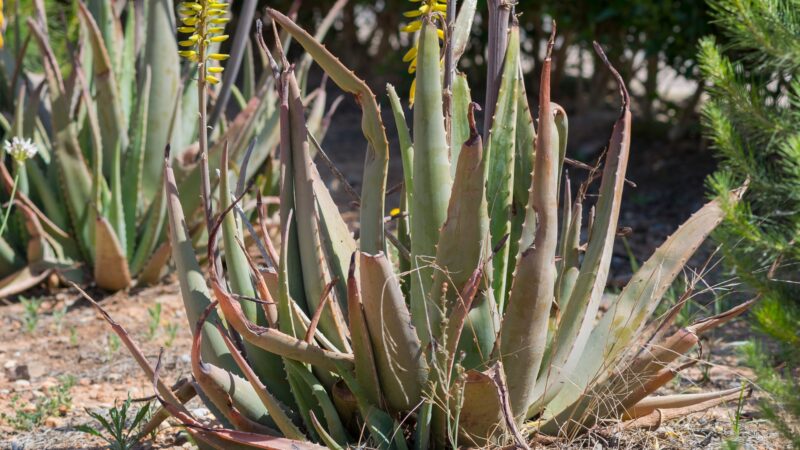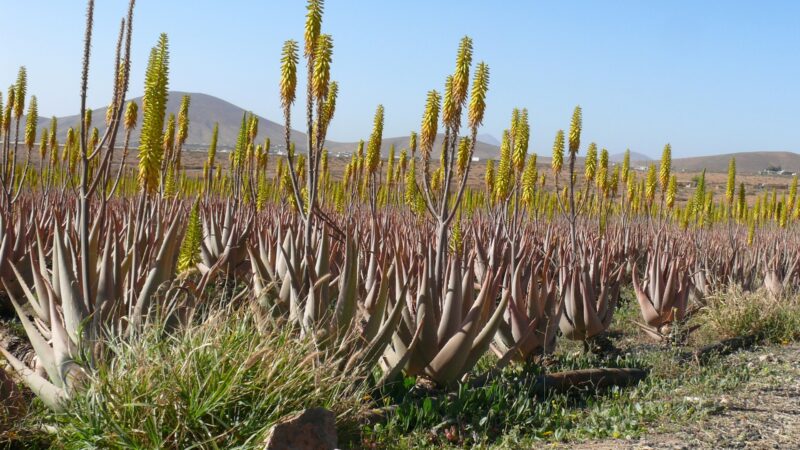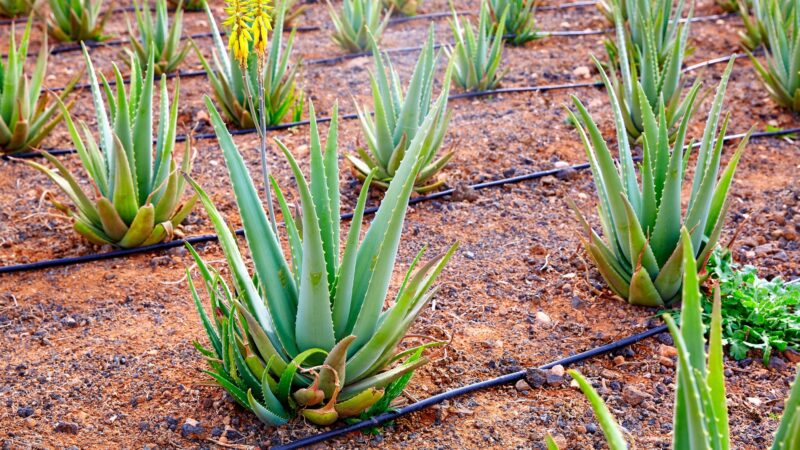There’s no denying that aloe vera is one tough plant. Being a member of the succulent family, it doesn’t require a lot of care to survive. However, being a tough plant doesn’t mean that it is not in danger of dying. To make sure you take good care of your aloe vera plant, you have to identify the reasons that may cause it to die.
So, what are the causes of a dying aloe vera plant? An aloe vera plant may die because of the following reasons:
- It was overwatered.
- It is not getting enough water.
- It is sunburned.
- It is frozen.
- Its leaves are drooping.
- Its roots and leaves are rotting.
- It’s placed in a pot that’s not the ideal size.
- It’s not getting enough sunlight.
- There is a pest infestation.
This article will give you an in-depth discussion of each of the above causes and help you revive your dying aloe vera plant. You’ll also learn some tips and tricks to make sure you’re taking good care of your dying plant. Just continue reading to learn all about them.
What Does an Unhealthy Aloe Vera Plant Look Like?

An aloe vera plant is known for its iconic plump and green-colored leaves. These leaves appear straight and pointed, no matter how thick and heavy they appear. If you have an unhealthy aloe vera plant, these are the signs that you should look out for:
- Yellowish leaves. As earlier stated, a healthy aloe plant will have green leaves. When it has yellowish or brown leaves, this is a sign that it’s not getting enough water and will dry out eventually.
- Brown tips. A healthy aloe vera plant will have a pointed and green-colored tip. However, an unhealthy one will have withering brown tips.
- Drooping leaves. An aloe vera’s leaves will always look upright, regardless of how thick and plump it looks. If it starts to droop, this is a sign that something’s wrong with your plant.
- Decaying parts. The biggest tell-tale sign that your aloe vera plant is dying is if it starts to have decaying parts. Whether it is the leaves or its roots, decaying plant parts are always a bad sign.
Causes of a Dying Aloe Vera Plant

There are several reasons that may cause an aloe vera plant to die. This includes overwatering, underwatering, exposing them for too long under the sun, exposing them to freezing conditions, planting them in pots that are too small, and a pest infestation, to name a few.
Overwatered Aloe Vera Plant
An aloe vera plant belongs to the succulent family of plants. As such, it does not require a lot of water to survive. That’s why overwatering your aloe vera plant may cause it to die.
This is one of the common causes of a dying aloe vera plant. It may be due to giving them too much water or that the pots do not allow proper water drainage – resulting in a plant that’s completely soaked in water.
- Symptoms: When an aloe vera plant is overwatered, its leaves will have a soft and mushy texture – as opposed to its usual firm texture. It will also start to look yellow or brown since it is starting to die. In some cases, the stems will also start to collapse.
- Causes: Overwatering may be due to sprinkling the aloe vera plant with too much water or the pot having a poor drainage system.
- How to revive: To revive an overwatered aloe vera plant, it is best to take it out of its soaked condition and transfer it to a pot with well-draining soil. Make sure to take extra precautions while doing so since the soggy leaves are quite fragile. To prevent this from further happening, you can add a layer of pebbles on top to help the water drain properly.
Underwatered Aloe Vera Plant
Just like overwatering, underwatering is another common cause of a dying aloe vera plant. While an aloe vera plant requires little sprinkling once every week or every other week, it still needs water from time to time. Otherwise, it will dry out and die eventually.
- Symptoms: The best tell-tale sign that an aloe vera plant is not getting enough water is that its leaves start to turn brown – especially at the tip. The leaves will also start to look dry and less plump. Also, the soil on the pot will look dry.
- Causes: The biggest culprit is that the aloe vera plant is not getting enough water, leaving it dry and dull. As a result, it cannot fully absorb all the nutrients from the soil.
- How to revive: The easiest way to revive an aloe vera plant that’s not getting enough water is to give it water. As a rule, an aloe vera plant needs water every one to three weeks, depending on its condition. You can start by watering it once a week until it looks healthy enough for you to transition to watering it every two or three weeks. You can also add potting mix into the soil to help it absorb more nutrients faster.
Sunburned Aloe Vera Plant
An aloe vera plant does not need prolonged exposure to the sun. Exposure to the sun for around six hours per day would suffice to keep it healthy. Unfortunately, if it gets exposed for prolonged periods, especially if it is under direct sunlight, it might get sunburned. As a result, it dries out fast and could even wither and die if not given immediate care.
- Symptoms: A common symptom of a sunburned aloe vera plant is that it has brown spots on its leaves. It also shares common symptoms as an under-watered aloe vera plant, such as brown tips and leaf shrinking.
- Causes: Prolonged and direct exposure to sunlight.
- How to revive: To revive a sunburned aloe vera plant, the first thing you have to do is to keep it away from direct sunlight. Keep it indoors for a while, and make sure it gets enough water. During this time, it can derive its sunlight indirectly by placing it across a window. Also, make sure that the soil is moist – and not completely dry.
Frozen Aloe Vera Plant
While an aloe vera plant is cold-hardy, it is not frost-tolerant. When exposed to chilly or freezing temperatures, it can easily freeze over due to the water content.
- Symptoms: If an aloe vera plant is frozen, its leaves will start to shrink and shrivel. Its leaves will also turn a pale yellow.
- Causes: It is exposed to freezing temperatures for prolonged periods.
- How to revive: Unfortunately, the only way to revive a frozen aloe vera plant is if it still has green-colored leaves. In this case, you have to carefully separate the green leaves from the frozen and discolored leaves and transfer them to a new pot.
To ensure a successful revival, you can use special soil that’s meant to help grow aloe vera. This way, it can absorb the nutrients to help it recover from its frozen condition faster. Also, make sure to place the pot in a warmer area that’s not lower than 40 degrees Fahrenheit. If the room temperature is lower than this, the aloe vera plant is at risk of freezing again.
Drooping Aloe Vera Plant
Bear in mind that a healthy aloe vera plant has leaves that stay upright. With that said, a plant that has drooping leaves is a sign of poor health. This is true even if the leaves stay green.
This is often a sign that the plant is not getting enough sunlight to help with its photosynthesis. And in most cases, the leaves may even start to fall off of the plant.
- Symptoms: As its name implies, a drooping aloe vera plant will have leaves that appear to be slumping instead of the usual upright appearance. Additionally, even if the leaves look healthy and green, they may easily fall off.
- Causes: The primary cause is not getting enough sunlight or that the plant has been indoors for prolonged periods.
- How to revive: In the case of a drooping plant, the best way to revive it is to put it under direct sunlight. You can place it by the window to make sure it gets enough sunlight, but make sure that it does not exceed six hours. If it has been raining for days, you may place the plant under a study lamp until exposure to sunlight is available.
Additionally, to prevent the leaves from further drooping, you may also prune the leaves regularly.
Rotting Aloe Vera Plant
You know an aloe vera plant is dying when parts of it are beginning to rot. It starts when the aloe plant loses its green color and turns a pale yellow or brown. You can also observe the same discoloration at the base of the plant.
- Symptoms: The usual symptom of a rotting aloe vera plant is its leaves turning yellow or brown. You can also observe that its usual plump texture has turned mushy. The plant’s roots will also start to rot, with signs of it showing at the base.
- Causes: A rotting aloe plant may be caused by poor exposure to sunlight, too much watering, or fungal growth.
- How to revive: To ensure revival, immediate replanting is essential. But to do so, you have to carefully remove all the rotting parts – whether it’s the roots or the leaves. Once you have identified and separated the healthy parts, you should replant them immediately. To ensure the healthy parts survive, it’s best to use a liquid fertilizer for easier absorption.
Incorrect Pot Size
Like all plants, aloe vera plants also need to be planted inside a pot that’s the right size. If the pot is too small, the aloe plant won’t have enough room to grow its roots, and that will eventually cause it to rot. In contrast, a pot that’s too big will give the roots too much space to spread out, and that will cause a delay in the growth of the aloe plant.
- Symptoms: The biggest symptom of an incorrect pot size is that the aloe plant is growing slowly.
- Causes: The pot is either too big or too small.
- How to revive: To revive the aloe vera plant, you can simply re-pot the plant. As a rule, the ideal pot will be around ⅓ larger than the roots. Preferably, choose a pot that’s wider than the growth of the roots since aloe vera roots grow horizontally.
Not Enough Sunlight
Sunlight is essential to ensure photosynthesis and overall plant health, which is true for all plants. True enough, different plants require different levels of sunlight, and aloe vera needs only around six hours of sunlight per day. Without it, an aloe plant loses its beautiful green color and upright appearance.
- Symptoms: When an aloe vera plant is not getting enough sunlight, its leaves turn a pale yellow. The plump and upright appearance also starts to droop. And instead of having firm leaves, the aloe plant’s leaves will have a mushy texture.
- Causes: The aloe plant is not getting enough sunlight. In some cases, the plant is not getting enough sunlight while also getting too much water – hence the mushy texture.
- How to revive: An aloe vera plant that’s not getting enough sunlight is the easiest to revive. Simply place it in an area where it will get direct sunlight for six hours a day – like near the window of your home. If the sun is not visible, an alternative method is to place the aloe plant under a lamp for the same amount of time.
Pest Infestation
Aloe vera plants are also susceptible to pest infestations. Its most common pets include sap-sucking insects like aloe mites and aphids.
- Symptoms: When there is a pest infestation, a cluster of aloe mites and aphids are visible on the plant leaves.
- Causes: A pest infestation may be due to overwatering, or there is dead plant matter that has become suitable food for larvae.
- How to revive: The best way to revive an aloe vera plant that’s exposed to a pest infestation is to apply insecticides to kill the bugs.
To prevent another infestation from occurring, it is advised to prune your aloe plant regularly. By doing so, you are getting rid of any plant matter that’s rotting so that it won’t attract pests.
Taking Care of a Dying Aloe Vera Plant

- Always watch out for the signs. Before jumping into action to save your dying aloe vera plant, make sure to identify the root cause of it first. This will help you treat the very cause and save your plant as soon as possible.
- Use the finger test. If you think your plant is not getting enough water, you can use the finger test to determine if the soil is too dry. To do so, simply stick your finger into the soil until it is about two inches deep. If the soil at that depth is dry, then your aloe plant needs more water.
- Make sure that the soil is moist but not soaked. An aloe plant only needs light misting once or twice a week. If overwatered, it will lead to mushy leaves that will rot soon enough.
- Make sure it only gets around six to eight hours of sunlight. This is especially true if your dying aloe plant is not getting enough sunlight.
- Always observe your dying aloe plant. While a healthy aloe vera plant won’t require too much of your time, the same is not the case when it is already dying. It will need extra attention, and it will depend on the cause of its condition. Make sure that you don’t make the same mistakes again.
While the aloe vera plant is known for being hardy, it still needs minimal care to survive. To make sure that it doesn’t end up dying, make sure that it’s still getting enough sunlight and the right amount of water, you should also check on it regularly in case of a pest infestation. As long as you keep these pointers in mind, your aloe vera plant will surely be healthy.